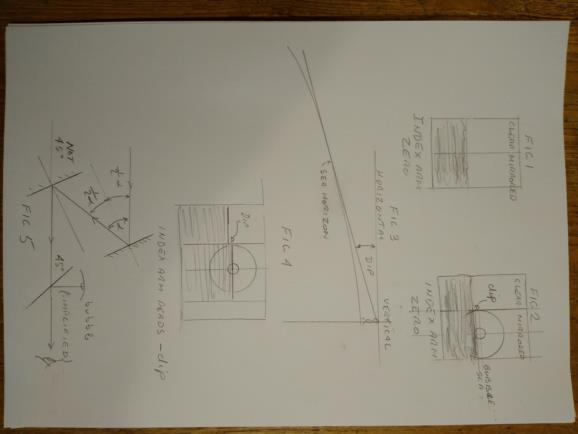
NavList:
A Community Devoted to the Preservation and Practice of Celestial Navigation and Other Methods of Traditional Wayfinding
From: David Pike
Date: 2022 Mar 24, 17:07 -0700
Dale Litchtblau you wrote: Does anyone use the C&P bubble sextant? Does it appear to be mis-aligned with the horizon mirror? I have a query into C&P.
Dale
TIKI is my 1973/4 27’x9’ Marcon Sabre fin keeled sloop, which has kept me safe for the last 23 years and taken me from the Humber as far as Sweden and back via Holland, Germany, and Denmark. These days I just potter around in the Humber.
I used bubble sextants professionally for 14 years at all levels from sea level to FL430 including 18 months teaching students how to use them. Since then, it’s been just for fun and amassing a collection. My interest in marine sextants started at junior school when my father would let me play with his. Of recent years I’ve acquired a 1941 Hughes Three Circle 6” Mates sextant plus a couple of eBay EBCOs, but it’s always been just for fun. I’ve never used them professionally. I also designed and produced a plywood sextant as a project while qualifying to teach Schools Technology.
With a bubble sextant, the bubble defines the vertical. However, we require the horizontal, so somewhere within the bubble assembly, the light through the bubble is turned though 90 degrees, usually by a mirror or prism set at 45 degrees to the light path through the bubble. Also at this stage, light though the bubble is cunningly merged with light from the celestial body, which has arrived via the index mirror. Now the human eye doesn’t feel happy looking at the image of the bubble about two inches in front of it and the image of the celestial body millions of miles away simultaneously, so a collimating lens within the bubble unit focuses the light from the bubble at infinity too. To save the observer holding the bubble against a single fiduciary mark, the top of the bubble chamber, where the bubble sits, is ground so that its radius of curvature is to equal the focal length of the collimating lens. Magically, this makes the celestial body and the bubble to move in unison over a significant portion of the field of view should the sextant be tilted slightly in the fore and aft direction.
So that said, comparing the standard working of a marine sextant with a bubble attachment version is a bit like comparing apples with oranges. They’re both round, but that’s about as far as it goes.
My first action upon receiving a sextant with a bubble attachment would be to take a few sights and check them against Frank Reeds GPS Anti-Spoof App (remembering to set the app to ‘bubble’ and ‘centre’). That’s assuming of course that you can entice a bubble from its hiding hole, which might require a certain amount of ‘horse whispering’ with some bubble chambers. In the event of an unacceptable difference, I wouldn’t attempt to tweak any small screw foolish enough to have made itself accessible unless I was sure I knew what I was doing. Even then, I’d think hard about whether my amateur twiddling’s could make a significant long-term improvement bearing in mind that small screws having made a comfortable seat for themselves sitting in the same position for years rarely seem happy elsewhere, as my EBCOs, bought specifically to practice sextant adjusting with, prove only too well.
Upon receiving a sextant direct from the Sextant Adjuster, if you set the index arm to zero and looked at the sea horizon, you would see something like fig 1. If you then swapped to the bubble attachment leaving the index arm at zero, you’d see something like fig 2. The sea horizon is below the centre of the bubble because of dip fig 3. If you twisted the micrometre drum to bring the sea horizon to the centre of the bubble (fig4), the index arm would read minus the angle of dip. You have effectively completed a deflection sight of the sea horizon. Alternatively, if you tweaked the 45° mirror in the bubble attachment, leaving the index arm at zero, your bubble attachment would no longer be giving you the correct horizontal, and all your subsequent sights on celestial bodies would overread by the dip at the spot you made the adjustment.
Turning to the marine front end of your sextant, light from a distant object, is turned though twice the angle between the index and the horizon mirrors. Therefore, when the index arm reads zero, the two mirrors must be parallel. However, this doesn’t mean they have to be set at 45 degrees to the line of sight like the mirror or prism in the bubble attachment. The actual angle depends upon where the mirror axles are set in the sextant frame. To find the angle draw the pivots, draw the Z in; divide the two Vs into two equal halves; and draw lines perpendicular to those lines. These are the angle that the index and horizon mirrors should be set at when the index arm reads zero (figure 5). Therefore, don’t expect all three mirrors to be parallel. Homework question. If the horizon mirror axis is two inches below and two inches forward of the index mirror axis which angle must the horizon mirror be set to the line of sight? DaveP







